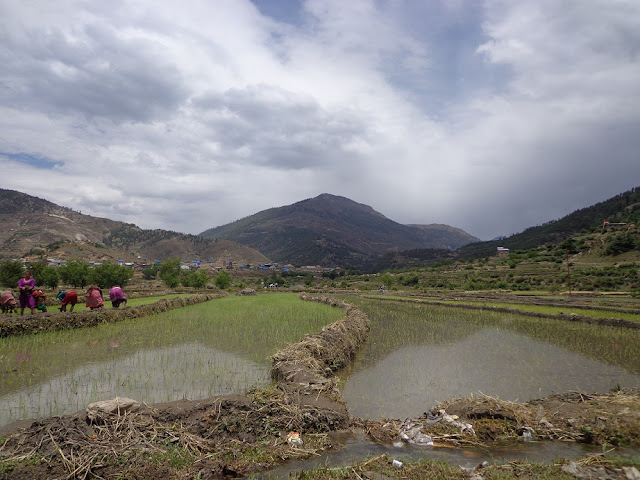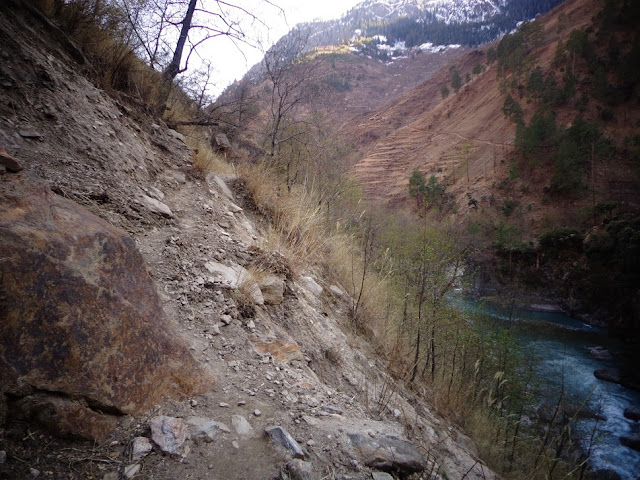 |
| The jungles of Mugu (photo: Vivek Singh) |
We were very excited
that night because it was kind of a mini feast, and on the plate was meat. Our excitement,
however, quickly turned into bitter disappointment and annoyance, because what
was to be delicious food got cooked rather blandly (Sauji (the shop owner) was a
close-fisted chap whose number one priority was cash, not customer
satisfaction. I can’t blame him though; adversity brings out the worst in
people).
Anyways, it was around
9:00 pm in a place called Bakaura, and our lodge for the day was a small hotel with a galvanized
iron roof (oh, now that’s posh!!) in the middle of the foot trail from Humla to
Mugu, two of the most remote districts in Nepal where I was working in, which ran through a dense jungle. There were no settlements and houses
within an hour’s walk. That hotel in Bakaura was isolation objectified.
In the kitchen, with a
bowl filled with meat is his hand were me, Vivek (a colleague and friend) and three
remarkably garrulous people from another close-by district called Kalikot. The others were Sauji, his
wife, and who could forget, Ain.
Ain was one of our
survey helpers, and that morning, he could not go to work because he had a
problem with his knees (we later found out that he was suffering from high uric
acid levels). When I had returned back from work at around 6:00 pm that
evening, I had a small chat with Ain because he was not looking good. I found
out that he was also down with a mild fever, but he reassured me that it was
not a problem and that he would be up and running the next day.
So, amidst all the
know-it-all, pretentious and trivial conversations of the men from Kalikot, the
outright disappointment of our taste buds and the blistering smoke from the
kitchen fire, Vivek and I were still trying to have a good time. Meanwhile, Ain
was resting in a bed.
 |
| Protagonist Ain with fellow survey helpers (photo: Tika Maden) |
Because Ain was not feeling
so good, his daal-bhat (rice and lintels) had already been prepared and served. Sauji called
out to him a number of times, but he did not respond. We thought he had fallen
asleep, so we decided to wake him up. Our concern started growing when he did
not respond even to several nudges. I felt his forehead and he was burning hot.
We were in the middle of nowhere, and apparently, this lad was unconscious due
to high fever. The nearest health post was hours away, and there was not enough
manpower to carry him there. It was then when the three blokes from Kalikot
took notice of our concerns. “Don’t worry sir, he will be fine”, one of them
said, dismissing our fuss as if it was nothing. At that point, Ain was
shivering, and was muttering things off his mouth that was creeping me out a
little.
According to Sauji,
he was doing fine in the afternoon and the evening as well, and was scratching
his head thinking what could possibly have happened to him all of a sudden. “I don’t
understand”, he said, “He was doing so good, I even gave him a bottle of Dolphin” (dolphin, probably the cheapest Gin in the world).
So, this was what had
happened. Ain was trying to recover from a uric acid impact and was resting,
and had “helped” himself with 180 ml of alcohol, and Sauji was “kind”
enough to give it to him (providing what the customer wants for their satisfaction;
oh the irony). We found out that Ain had been sleeping the whole day without
food and water, and had worsened his situation with Dolphin.
With that revelation,
we guessed that he was dehydrated, so we tried to get him to drink water, unsuccessfully.
All the while, the people from Kalikot were insistent that we let the matter
go, and that he would be fine. Vivek and I were city boys, and sure enough,
this was a panicky situation. Ain’s mumbles were getting louder by the second,
his eyes were flipping and his shivers were getting stronger.
Now as I said, there
were three people from Kalikot, and two of them were rattling about how they
had seen a dozen cases like this, and how he’d be fine and how they had seen a
couple of people die under the same circumstances (??). The third one had not said
a word. Then, he decided it was time.
“He has been possessed”,
said the third guy. We saw that he was tipsy, courtesy to Dolphin. “Leave him.
I will take care of him”.
I feel guilty that I
found the situation a tad funny at a time like that. I nudged my friend to
leave Ain and see what tricks he had up his sleeve.
The man pulled Ain out
of his bed and started with a tight slap to his cheek. At that point, Vivek and
I were too rattled by his actions to do anything. “Mero Kanchu lai kasle
samatyo!! Oye Bhut!!! Chod mero kanchu lai! (This is too good to translate
to English, but what i can say is that he was talking to the demon who had "possessed" Ain)”, he said, shaking the life out of him. Ain had that usual mumbling
and shaking going on for him. Before we could stop him, he started delivering
blows to Ain’s back. The whole situation was down-right hysterical. We watched
in horror as the man got more and more excited with his Kanchu (the guy was reffering to Ain as Kanchu, a term you use to a younger person with love) when all
of a sudden, there was an “Aiya (ouch)” from Ain.
Ain was getting better??!!
He started regaining his senses, and with each blow, Ain seemed to be returning
back to his usual self. The man’s extreme drunken tricks were working, and
after a while, we decided it was enough, and so, we took over. We managed to
feed him a bowl of milk and rice, and by the time the bowl was empty, Ain was
almost completely fine. The next day, like he said earlier, Ain was up and
running.
 |
| Bakaura, where it all happened (photo: Tika Maden) |
Maybe it was Ain’s own consideration of being
possessed by a demon that did the trick for him, or it was because the exorcist
beat the sickness out of him. Either way, I was glad in the end that the three
obnoxious people were there with us that night.
























